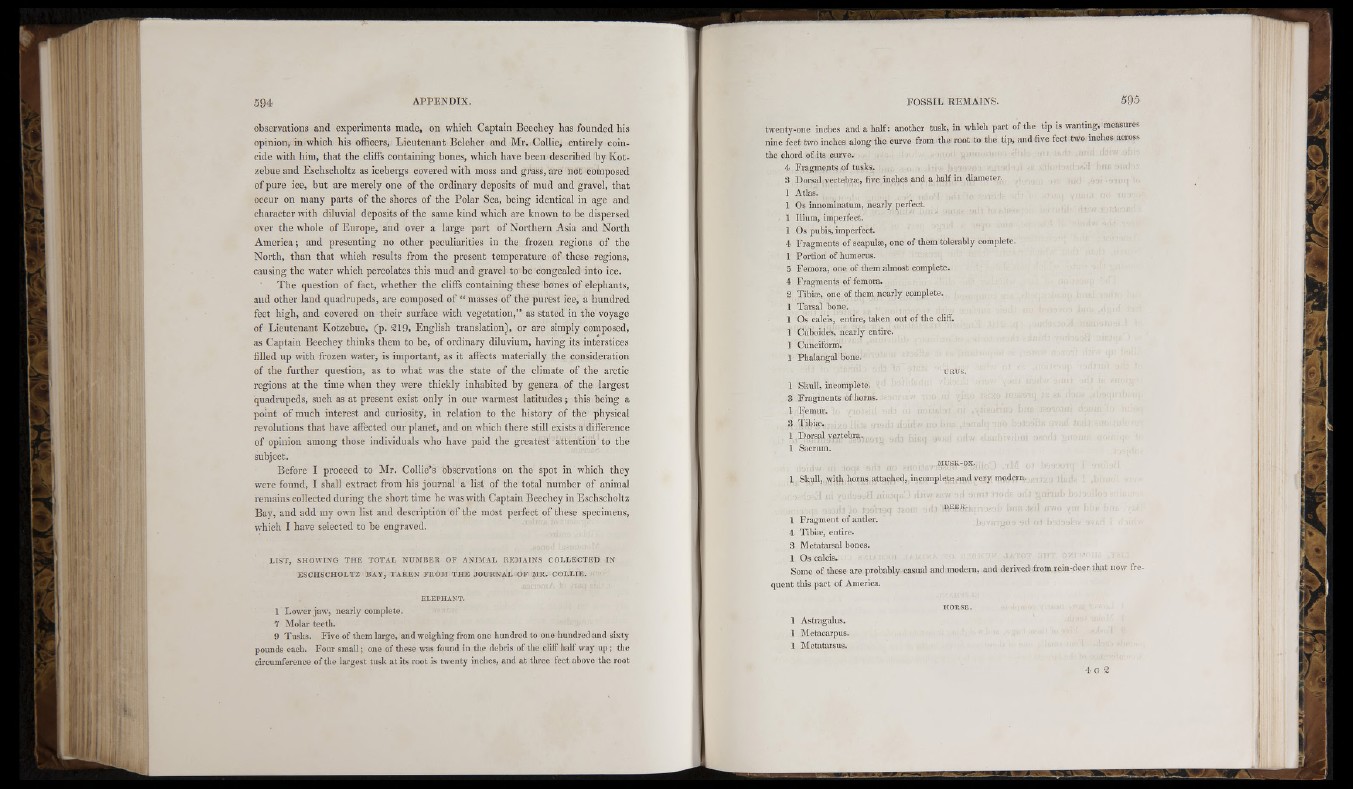
i l l '
Mil I ,
I':;*, ;
r i ¡■‘t
observations and experiments made, on wbich Captain Beechey has founded his
opinion, in which his officers. Lieutenant Belcher and Mr. Collie, entirely coincide
with him, that the cliffs containing bones, which have been described by Kotzebue
and Eschscholtz as icebergs covered with moss and grass, are not composed
of pure ice, but are merely one of the ordinary deposits of mud and gravel, that
occur on many parts of the shores of the Polar Sea, being identical iu age and
character with diluvial deposits of the same kind which are known to be dispersed
over the whole of Europe, and over a large part of Northern Asia and North
America; and presenting no other peculiarities in the frozen regions of the
North, than that which results from the present temperature of these regions,
causing the water which percolates this mud and gravel to be congealed into ice.
The question of fact, whether the cliffs containing these bones of elephants,
and other land quadrupeds, are composed of “ masses of the purest ice, a hundred
feet high, and covered on their surface with vegetation,” as stated in the voyage
of Lieutenant Kotzebue, (p. 219» English translation), or are simply composed,
as Captain Beechey thinks them to be, of ordinary diluvium, having its interstices
filled up with frozen water, is important, as it affects materially the consideration
of the further question, as to what was the state of the climate of the arctic
regions at the time when they were thickly inhabited by genera of the largest
quadrupeds, such as at present exist only in our warmest latitudes; this being a
point of much interest and curiosity, in relation to the history of the physical
revolutions that have affected our planet, and on which there still exists a difference
of opinion among those individuals who have paid the greatest attention to the
subject.
Before I proceed to Mr. Collie’s observations on the spot in which they
were found, I shall extract from his journal a list of the total number of animal
remains collected during the short time he was with Captain Beechey in Eschscholtz
Bay, and add my own list and description of the most perfect of these specimens,
which I have selected to be engraved.
ri
II tori
i,«,1i.1h II
L I S T , S H O W IN G T H E T O T A L N U M B E R O F A N IM A L R EM A IN S C O L L E C T E D IN
E S C H S C H O L T Z B A Y , T A K E N F R O M T H E JO U R N A L O F M R . C O L L IE .
ELEPHANT.
1 L ow e r jaw , n e a rly complete.
7 M o la r te e th .
9 Tu sk s. F iv e of th em large , an d we ig h in g from one h undred to one hundred and sixty
pounds each. F o u r sm a ll; one o f these was found in th e debris o f th e cliff half way u p ; the
circumference o f th e large st tusk a t its root is tw en ty inches, and a t th ree fe et above the root
twen ty -o n e inches and a h a lf: anothe r tusk, in which p a rt o f th e tip is wanting, measures
n in e fe e t two inches along th e curve from th e ro o t to th e tip, and five fe et two inches across
th e chord of its curve.
4 Fragm en ts o f tusks.
3 Dorsa l vertebra;, five inches and a h a lf in diameter.
1 Atlas.
1 Os innominatum, n ea rly perfect.
1 Ilium, imperfect.
1 Os pubis, imperfect.
4 F ragm en ts of scapulse, one of them tolerably complete.
1 P o rtio n o f humerus.
5 F emora, one o f them almost complete.
4 F ragm en ts o f femora.
2 Tibiae, one of them n ea rly complete.
\ T a rsa l bone.
1 Os calcis, en tire , tak e n out of th e cliff.
1 Cuboides, n ea rly entire.
1 Cuneiform.
1 P h a lan g a l bone.
URUS.
1 Skull, incomplete.
3 F ragm en ts o f horns.
1 Femur.
3 Tibiie.
1 Dorsa l vertebra.
1 Sacrum.
MUSK-OX.
1 Skull, with horns attached, incomplete an d v e ry modern.
tori!
1 F ragm en t o f antler.
4 T ib ia ', entire.
3 Metatarsal bones.
1 Os calcis.
Some o f tliese are probably casual an d modern, and derived from re in-dee r th a t now freq
u en t this p a rt of America.
1 Astragalus.
1 ^Metacarpus.
1 Metatarsus.